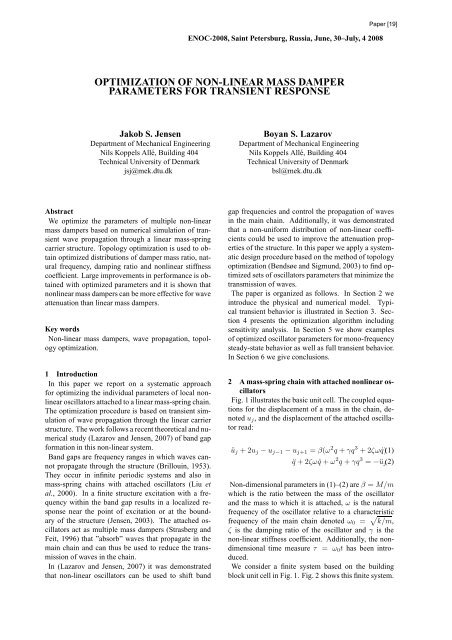WAVES AND VIBRATIONS IN INHOMOGENEOUS STRUCTURES ...
WAVES AND VIBRATIONS IN INHOMOGENEOUS STRUCTURES ...
WAVES AND VIBRATIONS IN INHOMOGENEOUS STRUCTURES ...
You also want an ePaper? Increase the reach of your titles
YUMPU automatically turns print PDFs into web optimized ePapers that Google loves.
ENOC-2008, Saint Petersburg, Russia, June, 30–July, 4 2008<br />
OPTIMIZATION OF NON-L<strong>IN</strong>EAR MASS DAMPER<br />
PARAMETERS FOR TRANSIENT RESPONSE<br />
Jakob S. Jensen<br />
Department of Mechanical Engineering<br />
Nils Koppels Allé, Building 404<br />
Technical University of Denmark<br />
jsj@mek.dtu.dk<br />
Abstract<br />
We optimize the parameters of multiple non-linear<br />
mass dampers based on numerical simulation of transient<br />
wave propagation through a linear mass-spring<br />
carrier structure. Topology optimization is used to obtain<br />
optimized distributions of damper mass ratio, natural<br />
frequency, damping ratio and nonlinear stiffness<br />
coefficient. Large improvements in performance is obtained<br />
with optimized parameters and it is shown that<br />
nonlinear mass dampers can be more effective for wave<br />
attenuation than linear mass dampers.<br />
Key words<br />
Non-linear mass dampers, wave propagation, topology<br />
optimization.<br />
1 Introduction<br />
In this paper we report on a systematic approach<br />
for optimizing the individual parameters of local nonlinear<br />
oscillators attached to a linear mass-spring chain.<br />
The optimization procedure is based on transient simulation<br />
of wave propagation through the linear carrier<br />
structure. The work follows a recent theoretical and numerical<br />
study (Lazarov and Jensen, 2007) of band gap<br />
formation in this non-linear system.<br />
Band gaps are frequency ranges in which waves cannot<br />
propagate through the structure (Brillouin, 1953).<br />
They occur in infinite periodic systems and also in<br />
mass-spring chains with attached oscillators (Liu et<br />
al., 2000). In a finite structure excitation with a frequency<br />
within the band gap results in a localized response<br />
near the point of excitation or at the boundary<br />
of the structure (Jensen, 2003). The attached oscillators<br />
act as multiple mass dampers (Strasberg and<br />
Feit, 1996) that ”absorb” waves that propagate in the<br />
main chain and can thus be used to reduce the transmission<br />
of waves in the chain.<br />
In (Lazarov and Jensen, 2007) it was demonstrated<br />
that non-linear oscillators can be used to shift band<br />
Boyan S. Lazarov<br />
Department of Mechanical Engineering<br />
Nils Koppels Allé, Building 404<br />
Technical University of Denmark<br />
bsl@mek.dtu.dk<br />
gap frequencies and control the propagation of waves<br />
in the main chain. Additionally, it was demonstrated<br />
that a non-uniform distribution of non-linear coefficients<br />
could be used to improve the attenuation properties<br />
of the structure. In this paper we apply a systematic<br />
design procedure based on the method of topology<br />
optimization (Bendsøe and Sigmund, 2003) to find optimized<br />
sets of oscillators parameters that minimize the<br />
transmission of waves.<br />
The paper is organized as follows. In Section 2 we<br />
introduce the physical and numerical model. Typical<br />
transient behavior is illustrated in Section 3. Section<br />
4 presents the optimization algorithm including<br />
sensitivity analysis. In Section 5 we show examples<br />
of optimized oscillator parameters for mono-frequency<br />
steady-state behavior as well as full transient behavior.<br />
In Section 6 we give conclusions.<br />
2 A mass-spring chain with attached nonlinear oscillators<br />
Fig. 1 illustrates the basic unit cell. The coupled equations<br />
for the displacement of a mass in the chain, denoted<br />
uj, and the displacement of the attached oscillator<br />
read:<br />
üj + 2uj − uj−1 − uj+1 = β(ω 2 q + γq 3 + 2ζω ˙q)(1)<br />
¨q + 2ζω ˙q + ω 2 q + γq 3 = −üj(2)<br />
Non-dimensional parameters in (1)–(2) are β = M/m<br />
which is the ratio between the mass of the oscillator<br />
and the mass to which it is attached, ω is the natural<br />
frequency of the oscillator relative to a characteristic<br />
frequency of the main chain denoted ω0 = k/m,<br />
ζ is the damping ratio of the oscillator and γ is the<br />
non-linear stiffness coefficient. Additionally, the nondimensional<br />
time measure τ = ω0t has been introduced.<br />
We consider a finite system based on the building<br />
block unit cell in Fig. 1. Fig. 2 shows this finite system.

















